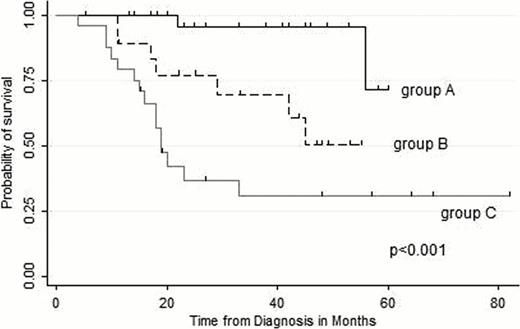Abstract
Abstract 1591
The use of fluorodeoxyglucose-positron emission tomography (PET) to aid the prognosis of patients with diffuse large B-cell lymphoma (DLBCL) after treatment with rituximab-containing combination chemotherapy was investigated. Several studies report that less than 20 % of patients who are PET-negative and more than 85 % of PET-positive patients will experience lymphoma recurrence. Since therapy for DLBCL recurrence remains a major problem, the ability to accurately predict the risk of relapse in PET-negative DLBCL patients after chemotherapy would be extremely beneficial. In this study we focused on levels of serum soluble interleukin-2 receptor (sIL-2R) since several reports indicate that sIL-2R at the time of diagnosis is closely linked to the prognoses of DLBCL patients. We measured sIL-2R levels in DLBCL patients shortly after R-CHOP therapy and investigated whether there was any correlation with patient prognoses.
This was a retrospective pooled analysis of DLBCL patients treated with R-CHOP in our institute. Patients were included if they were under the age of 80, had an International Prognostic Index (IPI) score of more than two, and had received R-CHOP with curative intent. Patients who received salvage chemotherapies due to insufficient responses to R-CHOP were also included. We excluded patients with low IPI scores as their sIL-2R levels at the time of diagnosis were usually in the normal range. Patients were also excluded if R-CHOP could not be continued for reasons other than disease progression. sIL-2R and PET analyses were performed when patients first visited the institute after completing 6–8 cycles of R-CHOP. Patients were divided into three groups: Group A consisted of patients who had completed R-CHOP, were PET-negative and whose sIL-2R levels had returned to normal (<600 mg/dl); Group B consisted of patients who had completed R-CHOP and were PET-negative, but whose sIL-2R levels had remained high (>=600mg/dl); Group C consisted of patients who had switched to salvage therapies as well as those who remained PET-positive after completing R-CHOP. Overall survival (OS) was assessed using the Kaplan-Meier method and the log-rank test was used for comparisons within each group. A multivariate Cox regression analysis was used to adjust for IPI scores.
From January, 2006 to January, 2012, a total of 178 DLBCL patients aged less than 80 years were referred to our institution, and 70 of these patients were included in this analysis. The median age of patients was 68 years (range 37–79 years), 96 % had advanced stage DLBCL, and 77 % had elevated lactate dehydrogenase levels. 30% of patients had ECOG performance status (PS) less than 2. The median sIL-2R level at the time of diagnosis was 2676 mg/dl (range 612–48000 mg/dl). The numbers of patients assigned to groups A, B, and C were 28 (40 %), 18 (26 %), and 24 (34 %), respectively. A Fisher's exact test showed no significant differences in IPI scores between the three groups (p=0.453). A Mann-Whitney test showed no significant differences in sIL-2R levels at the time of diagnosis between the three groups (A; median 2660 mg/dl, range 612–19000 mg/dl, B; 2905 mg/dl, 970–37100 mg/dl, C; 4347 mg/dl, 734–48000 mg/dl). Patients in groups A and B received 6–8 cycles of R-CHOP (median 7 cycles). Patients in group C received 1–4 salvage treatments (median 2 treatments) before or after completion of R-CHOP (median 6 cycles, range 2–8 cycles). After a median follow-up time of 36 months (range 5–60 months), 24 deaths had occurred (including 20 due to lymphoma), and the 3 year OS rate for the entire cohort was 65.5 % [95 % confidence interval (CI), 51.7–76.2 %]. The 3 year unadjusted OS rate of patients in groups A, B, and C was 95.2% [95%CI, 70.7–99.3%], 60.7% [95%CI, 31.3–80.6%] and 30.6% [95%CI, 12.5–51.0%], respectively (log-rank, p<0.001), (group A vs B; hazard ratio (HR), 10.8; 95%CI, 1.33–88.1; p=0.026, group B vs C; HR, 2.24; 95%CI, 0.91–5.54; p=0.079). Multivariate analysis including IPI score, revealed that 3 year OS for patients in group B was significantly inferior to that for patients in group A (HR, 6.26; 95%CI, 1.29–30.4; p=0.023), but was comparable with that for patients in group C.
DLBCL patients with an IPI score of more than 2 had an increased risk of relapse if their sIL-2R levels failed to return to normal following R-CHOP treatment, even if they completed 6–8 cycles of R-CHOP and were PET-negative.
No relevant conflicts of interest to declare.
Author notes
Asterisk with author names denotes non-ASH members.


This feature is available to Subscribers Only
Sign In or Create an Account Close Modal